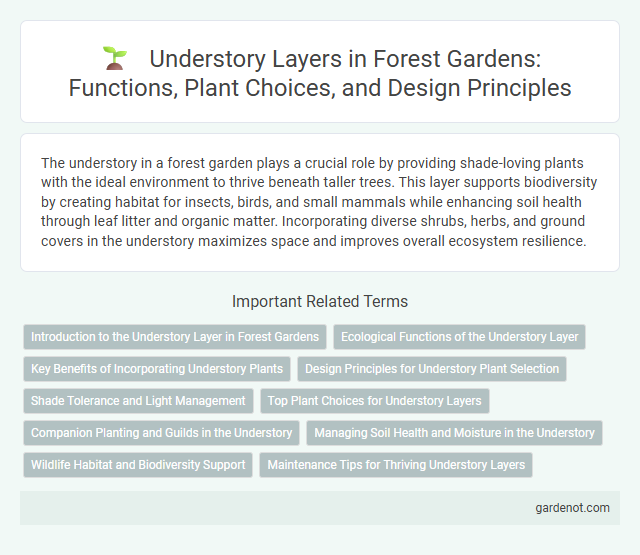The understory in a forest garden plays a crucial role by providing shade-loving plants with the ideal environment to thrive beneath taller trees. This layer supports biodiversity by creating habitat for insects, birds, and small mammals while enhancing soil health through leaf litter and organic matter. Incorporating diverse shrubs, herbs, and ground covers in the understory maximizes space and improves overall ecosystem resilience.
Introduction to the Understory Layer in Forest Gardens
The understory layer in forest gardens consists of shade-tolerant shrubs, small trees, and herbaceous plants that thrive beneath the canopy, playing a crucial role in ecosystem diversity and productivity. This layer provides habitat for beneficial insects, improves soil health through leaf litter decomposition, and produces fruits, nuts, and medicinal plants integral to the multilayered design. Understanding the species composition and ecological functions of the understory maximizes forest garden yields and supports sustainable agroforestry practices.
Ecological Functions of the Understory Layer
The understory layer in a forest garden provides critical ecological functions such as habitat for diverse wildlife species and regulation of microclimates through shading and moisture retention. This layer supports nutrient cycling by decomposing organic matter and facilitating mycorrhizal fungi networks that enhance soil fertility. Its role in protecting soil from erosion and promoting biodiversity contributes significantly to ecosystem resilience and productivity.
Key Benefits of Incorporating Understory Plants
Understory plants enhance forest garden ecosystems by improving soil health through nitrogen fixation and organic matter accumulation. These plants create microclimates that protect soil moisture and reduce weed growth, fostering biodiversity and pest control. Their presence supports pollinators and wildlife, contributing to a resilient and sustainable forest garden environment.
Design Principles for Understory Plant Selection
Understory plant selection in forest garden design prioritizes shade tolerance, soil moisture preferences, and complementary growth habits to optimize ecosystem balance. Species such as shade-adapted ferns, herbaceous perennials, and nitrogen-fixing shrubs enhance nutrient cycling and habitat complexity. Effective layering with understory plants increases biodiversity, supports pollinators, and improves microclimate regulation beneath the canopy.
Shade Tolerance and Light Management
The understory of a forest garden thrives with shade-tolerant plants such as ferns, shade-loving herbs, and dwarf shrubs that maximize limited light availability. Effective light management involves strategic canopy layering to regulate sunlight penetration, enhancing photosynthesis and growth beneath taller trees. Selecting species with adaptive leaf morphology and chlorophyll concentration optimizes energy capture in low-light conditions, promoting biodiversity and ecosystem resilience.
Top Plant Choices for Understory Layers
Shade-tolerant species such as American spicebush (Lindera benzoin), serviceberry (Amelanchier spp.), and pawpaw (Asimina triloba) thrive in the forest garden understory. These plants enhance biodiversity by providing critical habitat and food sources for pollinators and birds. Selecting native shrubs and small trees adapted to low light ensures a resilient and productive understory layer.
Companion Planting and Guilds in the Understory
The understory in a forest garden plays a crucial role in companion planting by providing shade, moisture retention, and nutrient cycling that benefit the entire ecosystem. Companion plants in this layer, such as shade-tolerant herbs, nitrogen-fixing shrubs, and pollinator-attracting flowers, form guilds that enhance soil fertility and pest resistance. Effective guild formation in the understory supports biodiversity, promotes sustainable growth, and optimizes space utilization beneath canopy trees.
Managing Soil Health and Moisture in the Understory
Managing soil health and moisture in the understory of a forest garden involves maintaining a rich organic layer through mulching with leaf litter and compost to enhance nutrient cycling and water retention. Incorporating deep-rooted perennial plants and ground covers helps stabilize soil structure, improve aeration, and reduce erosion. Regular monitoring of soil moisture using sensors or manual checks ensures optimal hydration for understory plants, promoting biodiversity and robust growth.
Wildlife Habitat and Biodiversity Support
The understory layer of a forest garden provides essential wildlife habitat by offering shelter, nesting sites, and food sources for various birds, insects, and small mammals. This densely vegetated layer supports biodiversity by fostering a microhabitat rich in native plants and pollinators, enhancing ecosystem resilience. By maintaining diverse perennial shrubs and shade-tolerant species, the understory contributes significantly to nutrient cycling and ecological balance.
Maintenance Tips for Thriving Understory Layers
Regular pruning and selective thinning are essential to maintain airflow and light distribution in the understory layer of a forest garden, preventing disease and promoting healthy growth. Mulching with organic materials like leaf litter or wood chips enhances soil moisture retention and nutrient cycling, crucial for the diverse understory plants. Monitoring for invasive species and promptly removing them ensures the native understory flora thrives without competition.
Understory Infographic

 gardenot.com
gardenot.com